Updates From The Field
First published in Sanctuary Asia,
Vol. 43
No. 2,
February 2023
Project Updates
A Sanctuary Report – December 2022 and January 2023
Notes, anecdotes and reports from Sanctuary Nature Foundation’s projects across the country.
Bajaj Electrical's Support For The Anant Bajaj Paryavaran Mitra Kids For Tigers Programme
In Mumbai, Maharashtra
Kids for Tigers, supported by Bajaj Electrical’s Anant Bajaj Paryavaran Mitra, conducted several audio-visual shows in schools across Mumbai. A hands-on butterfly garden-building session with excited kindergarten students of the Bombay International School was organised to educate students about the lifecycle of butterflies, plant-animal interactions, and to inculcate a love for plants and animals. The students were delighted to learn some amazing facts about butterflies.
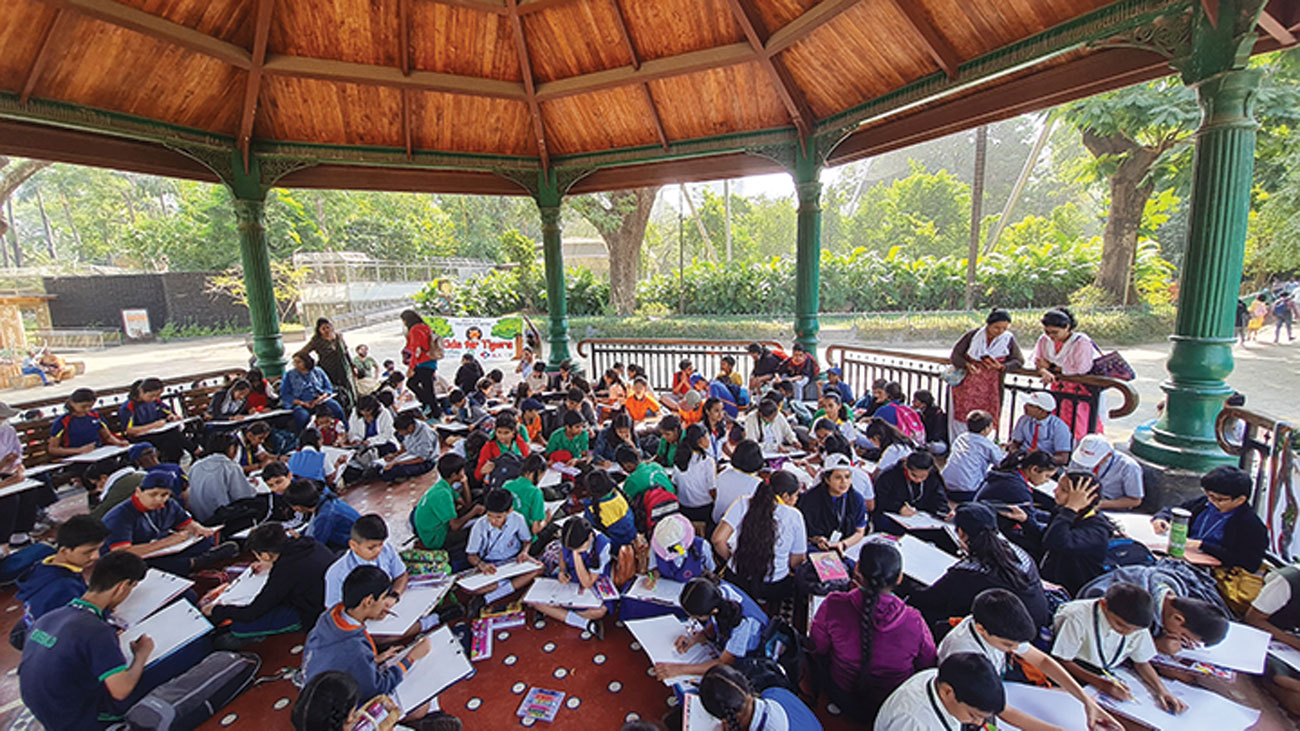
Students from various Mumbai schools participate in the Save the Tiger poster making competition organised by Kids for Tigers at Rani Bagh on January 14, 2023. Photo: Sanctuary Photolibrary.
A nature trail (third of the year), along with a ‘Save the Tiger’ event (second of the year) in collaboration with the Forest Department, was conducted at Rani Bagh, the popular name of the Veermata Jijabai Bhosale Vanaspati Udyan Prani Sangrahalaya – Mumbai’s only heritage botanical garden. Students from registered Kids for Tigers’ schools joined the trail. They were introduced to the city’s tree diversity and given examples of plant-animal interactions and interesting natural history tidbits. The trail was led by members of the Save Rani Bagh team. All participants received a book by children’s author Katie Bagli. Post the trail, the kids also participated in a poster-making competition on ‘What impressed me the most during the nature trail’. The event was attended by Revati Kulkarni Patil, Deputy Director (South) SGNP and Dr. Devanand Sirsat, Curator Zoo along with three forest guards, as well as Dr. Abhishek Nandkishor Neelam Satam, Zoo Biologist and Education and Public Relation Officer In-charge at the Botanical Garden and Zoo.
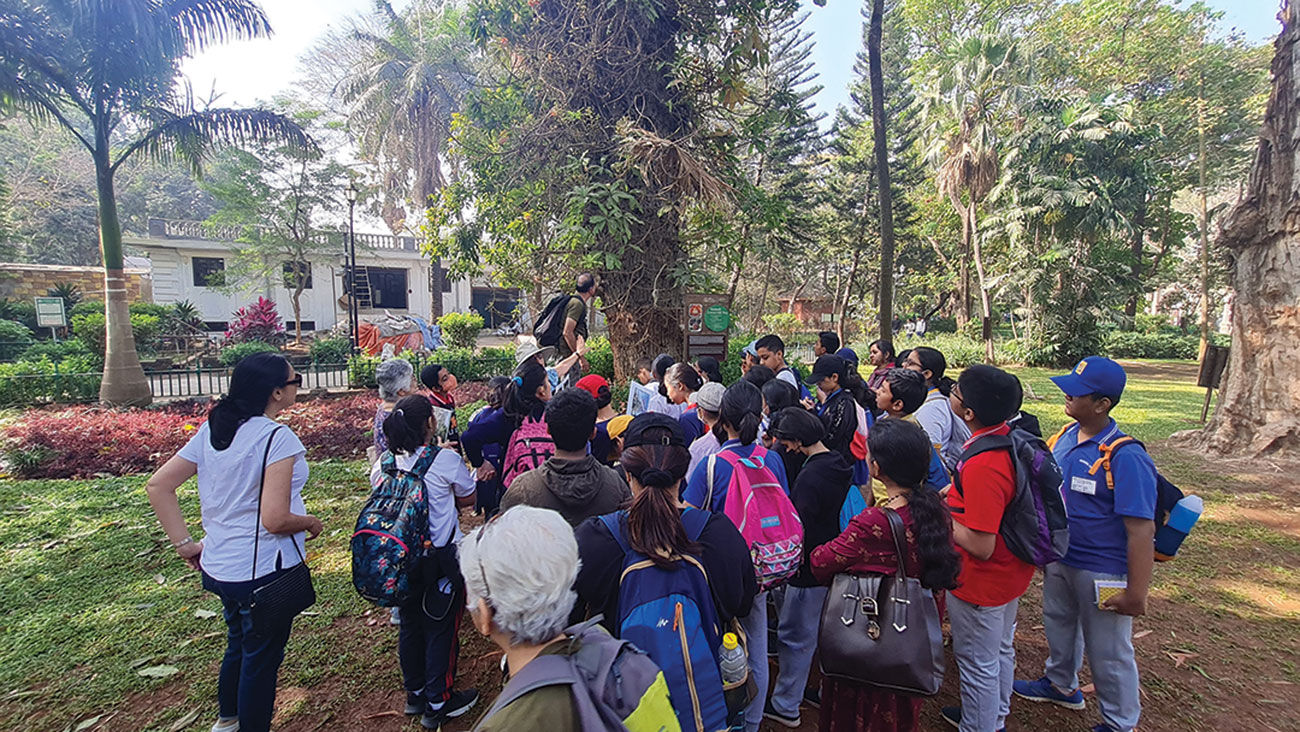
Dr. Parvish Pandya of the Sanctuary Nature Foundation and Hutokshi Rustomfram of the Save Rani Bagh team regale students with interesting facts about the canon ball tree during the nature trail at Rani Bagh. Photo: Sanctuary Photolibrary.
Art supplies for the poster-making competition were provided by Sanctuary. The first prize winner was given a BNHS student membership and a copy of Prabha Nair’s ‘So long, Amur Falcon’. The second prize winner was given a copy of Rohan Chakravarty’s ‘Bird Business’, and the third prize winner was given a coffee mug from BNHS. All kids received a certificate of participation.
HT Parekh Foundation Support For Kids For Tigers
In Kolkata, West Bengal
A leopard cat makes its kill, a kingfisher feeds on its prey, a Plaintive Cuckoo digs out an insect, small-clawed otters fish in brackish waters... A few young kids, chosen to be tomorrow’s environmental leaders, witnessed all these sightings and more within a span of three days at the Kids for Tigers residential camp in the Sundarban Tiger Reserve!
Post-pandemic, Kids for Tigers has been busy with a fun-filled tiger fest, four filled-with-discovery nature trails, audio-visual shows that revealed the wonders of wild India… and an annual camp in the heart of the largest mangrove forest in the world. Such were the delights to which students in schools registered for Kids for Tigers programme 2022-23 were treated. With the eight lucky students were eight teachers from different city schools, who woke to the calls of kingfishers, saw basking saltwater crocodiles and kept a sharp eye out for the elusive tiger. Down the years, we at Sanctuary have known that learning about the value of wild species and ecosystems is vastly improved with personal visits to wild India. The camp was planned and organised by Sanctuary’s partners from SHER, Joydip and Suchandra Kundu and it proved to be an effective platform for our youngsters to experience a truly magical mangrove ecosystem. Guided by ace naturalist Nityananda Choukidar, the participants quietly learned how the mangrove forest helped to temper the worst impacts of climate change – a crucial ecological service for the megalopolis of distant Kolkata. Kids for Tigers’ local coordinator young conservation-campaigner Manish Sarkar’s work is helping young people to absorb a greater understanding of human-wildlife coexistence that has been passed down the generations to local communities. The young campers and their teachers learned about the tidal dynamics, and interacted with those who share physical space with tigers. To introduce the city-dwellers to the Sundarban ecosystem, the iconic folk play, Bonobibi Paala was staged.

Students performing a skit at the Kids for Tigers’ annual Tiger Fest in Kolkata. Photo: Sanctuary Photolibrary.
The camp was concluded at the Bagh Bon Centre at Pakhiralay in the presence of Ajoy Kr. Das, CCF and Field Director of the Sundarban Tiger Reserve, who was accompanied by Avik Das, Range Officer of Sajnekhali Wildlife Sanctuary and Abhishek Dey, Deputy Ranger, West Bengal Forest Department. Before bidding goodbye, the teachers and students ceremoniously planted mangrove saplings (Kankra) at Bagh Bon as Field Director Ajoy Das looked on with pleasure at Kolkata’s future tiger ambassadors.
For the benefit of children from scores of Kolkata schools, a Kids for Tigers’ Fest was conducted on December 14, 2022 with over 450 students and teachers participating from as many as 41 Kolkata schools at the La Martiniere for Girls School. Here students presented performances on stage, all focused on tiger and nature conservation with a special emphasis on the Sundarban Biosphere ecosystem, including issues involving human-wildlife conflict. Posters, dance performances, music recitals, skits, short plays, elocution contests and recitations and a few fascinating power-point presentations on the theme ‘Vote for the Tiger’ were part of the fest. Every child received a certificate of participation and each attending school received a special Kids for Tigers’ plaque, that was presented by the much-loved Suchandra Kundu, who happens to be the Honorary Wildlife Warden of Kolkata.
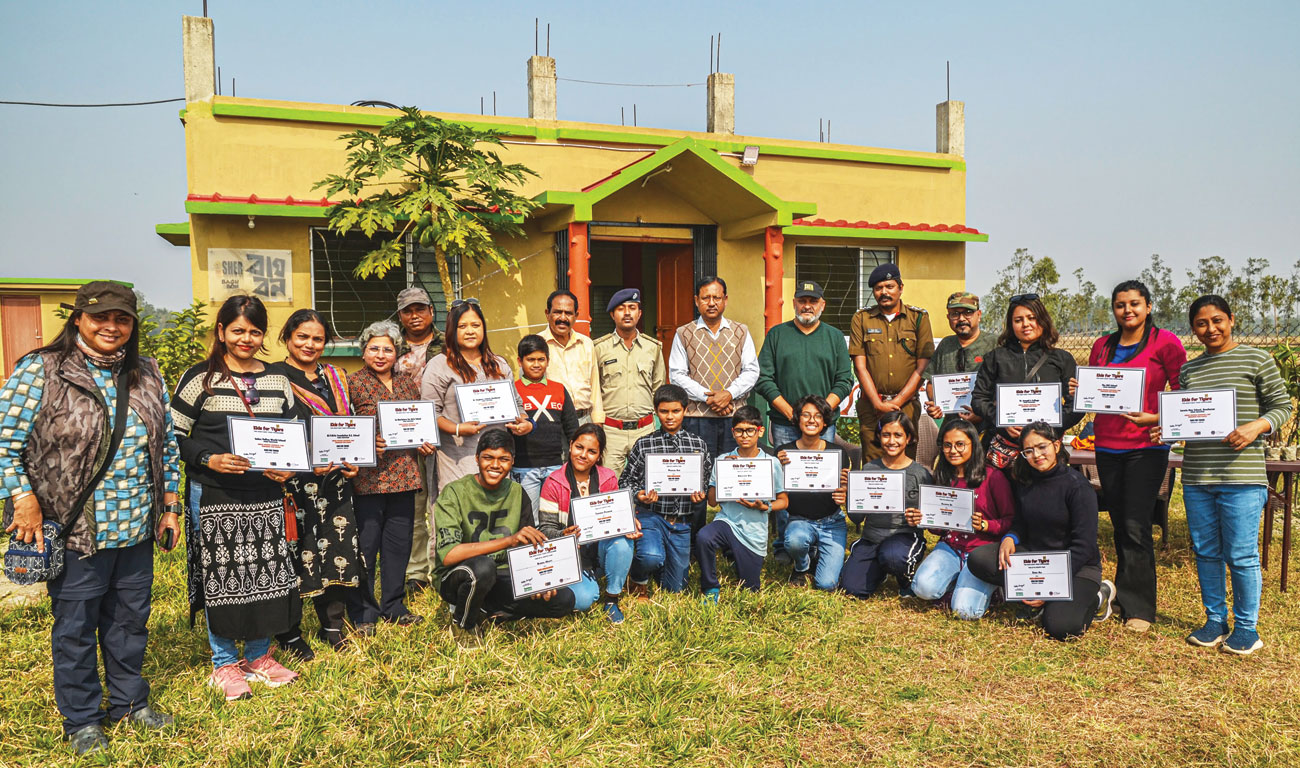
Tiger Ambassadors from Kids for Tigers, Kolkata, accompanied by their teachers and forest officials, proudly show off their certificates. Photo: Sanctuary Photolibrary.
HT Parekh Foundation Support For Community Events
In the Sundarban Biosphere Reserve, West Bengal
A series of well-planned activities were conducted at carefully chosen project sites in the Sundarban, including community interactions, forest guide training, a journalists meet, and more! Community interactions and film screenings continue in the Sundarban, and these are integral to connecting local communities, especially children, with issues concerning biodiversity protection and climate change.
It’s been a rich year for young people of the Sundarban with night film screenings, Art for Conservation events taking place at Sundarban’s Bali Island, where the Wildlife Protection Society of India (WPSI)’s Project Officer, Anil Krishna Mistry, who lives in and has spent his entire life in the Sundarban, organised a series of programmes for local villagers whose children participated in activities including creative art event, with one simple focus – the Sundarban Mangrove ecosystem and its star attraction, the tiger. Such events help bridge the gap between communities and the environment and help the local people get a global perspective on our rapidly changing climate.
_C-1300_1676454669.jpg)
Dr. Parvish Pandya addresses naturalists during the two-day nature guide training programme organised by Sanctuary and Wildlife Protection Society of India (WPSI) with the support of the West Bengal Forest Department’s Sundarban Tiger Reserve officials. Photo: Sanctuary Photolibrary.
In the Sundarban Tiger Reserve, local communities and visitors are oriented by forest guides appointed by the West Bengal Forest Department. This is to ensure that such guides are armed with the requisite skills and knowledge – not just about the tiger, but also about the entire mangrove ecosystem along with its rich biodiversity, critical conservation issues, the manner in which climate change is impacting both people and wildlife, plus the challenges that lie ahead and are also being currently faced by human and non-human residents of the Sundarban. For these initiatives, Sanctuary partnered with their long-time associates WPSI, headed by Belinda Wright, who was honoured with a special Sanctuary Tiger Award in 2005.
For the benefit of as many as 35 Sundarban forest guides, Sanctuary and WPSI organised a two-day training, with the support of the West Bengal Forest Department’s Sundarban Tiger Reserve officials. The workshop was held at the Interpretation Centre, Sajnekhali Wildlife Sanctuary on December 10 and 11 and included indoor and outdoor sessions designed to empower these crucial ambassadors with guiding skills, nature etiquette, birdwatching techniques, climate change awareness, biodiversity protection, and local conservation problems and solutions. The forest guides were addressed by Jones Justin, Deputy Field Director, Sundarban Tiger Reserve; Anil Mistry, WPSI; Prof. Shubhankar Banerjee, New Mexico University, U.S.A; and Dr. Parvish Pandya and Saurabh Sawant from the Sanctuary Nature Foundation. The interactive programme also focussed on the day-to-day problems guides encounter when dealing with tourists, and on creative ways to communicate information concerning conservation and the natural history interactions between wildlife. Such sessions not only help tourists get a perspective on the tough job that officials have, but also on how protecting the ecosystem ends up protecting people living far from the mangrove wonderlands. The long-term objective was not only to enhance the tourism experience, but to create more environment and conservation-savvy tourists who will respect and potentially help protect the Sundarban ecosystem.
_C-1300_1676454750.jpg)
Students of Bali Dhanamani Model High School during a nature trail in the Sundarban Tiger Reserve. Photo: Sanctuary Photolibrary.
Every participant at the workshop for forest guides was presented with a draft pocket-sized field guide and were asked to contribute their suggestions and corrections before the profusely illustrated guide was distributed to future visitors to one of the world’s most iconic tiger geographies.
Morningstar-India Support For Kids For Tigers’ Ranthambhore Village Contact Programme
In and around the Ranthambhore Tiger Reserve, Rajasthan
Sanctuary’s Kids for Tigers programme, supported by Morningstar-India, works in 45 villages located in the periphery of the Ranthambhore Tiger Reserve. Here, over two decades of consistent work by Govardhan Meena, one of the most popular people, much-loved by village children and much-admired by Ranthambhore’s forest officials, has yielded results in the shape and form of vastly improved people-park relationships. Additionally, a series of activities are held every week involving clean ups, wildlife conservation activities, reduction of human-animal conflict, health camps (during the pandemic) and regular visits into the park in coordination with the support of the Rajasthan Forest Department/Ranthambhore Tiger Reserve staff. In response to suggestions received from local youth, two Sanctuary Computer Laboratories have been set up in villages surrounding the Ranthambhore Tiger Reserve. The objective? To impart skills involving learning English and how to use computers to open doors for online jobs and livelihood opportunities. As many as 50 young village girls and boys registered for the training for the Rajasthan State Certificate Course in Information Technology (RS-CIT). A total of 50 students appeared for the exam held on January 22, 2023.
_C-1300_1676454917.jpg)
Local students perform a nukkad natak (skit) on tiger conservation to educate their peers about the threats tigers face. Photo: Sanctuary Photolibrary.
_C-1300_1676454997.jpg)
Jersey distribution to local kids to keep them warm during the harsh winters of Ranthambhore. Photo: Sanctuary Photolibrary.
Regular film screenings were organised through Sanctuary’s mobile education van to familiarise young and old alike about tiger conservation. Such sessions were held both in schools and in 45 Ranthambhore villages. With winter approaching, sweaters and gloves were gifted to government school students in December and January. What was very heartening was the fact that when young children enrolled for clean-up drives, some of their elders joined the initiatives as did forest officials who accompanied the group to offer security and advice. A primary result has been a greater awareness of the dangers of single-use and disposable plastic waste. We saw children explaining to adults how hazardous plastics can be when ingested by wild or domestic animals. The activities conducted are almost too numerous to list and include travelling wildlife poster exhibitions on the biodiversity of Ranthambhore in schools, drawing competitions, wildlife quizzes and nukkad natak events themed on tiger conservation. Throughout the month, visits were also organised to nearby museums in the company of Forest Department staff, the frontline workers defending and protecting our forests, most of whom live in the villages where the programmes are implemented.
_C-1300_1676455119.jpg)
An image can tell a story better and louder than words ever can. Kids appreciate a photo at the Wildlife Photography Exhibiton held in their school. Photo: Sanctuary Photolibrary.
IndusInd Bank Support For Kids For Tigers
In Six Locations Across India
In Bengaluru, Coimbatore, Delhi, Hyderabad, Nagpur and Khajuraho/Panna a series of Kids for Tigers’ initiatives are being supported by long-time Sanctuary partners, the IndusInd Bank. By working with diverse supporters, Sanctuary is managing to help children overcome the frustration of two pandemic years, even as their legitimacy and strength adds to the national objective of protecting our rivers, forests and wildlife. By infusing nature appreciation and a conservation ethic in children, we expect to create a new generation of urban and rural children, far more sensitive to nature than generations gone by. Using the tiger – our national animal – as a metaphor for all of nature, the Kids for Tigers Network across India now exceeds a million young children, their teachers, parents, and the communities in which they live. Designed by educationists, the programme has been recognised across the world. A carefully curated series of Teachers’ Environmental Leadership Workshops have been held in Nagpur, Delhi, Bengaluru, Hyderabad, Khajuraho/Panna and Coimbatore. In these centres, exciting and educative nature trails and wildlife events have drawn hundreds of people, young and old, who are exposed to critical connections between biodiversity protection and conservation, food, water and economic security and climate change.
In Nagpur, Maharashtra
Over a decade ago, a strong Sanctuary supporter, Hemendra Kothari, christened Nagpur as the Tiger Capital of India. Here we continue the inspirational Kids for Tigers’ work launched by the late Sulabha Chakravarty. By working with both vernacular and English medium schools, our message conveys that humans are as dependent on the biosphere as are the animals we wish to protect. Pandurang Pakhale, Assistant Conservator of Forest and Sanctuary Wildlife Service Awardee 2017, said he was delighted to interact with Kids for Tigers’ children who were conducted through the naturally exquisite surrounds of the Balasaheb Thackeray Gorewada International Zoological Park where they were able to birdwatch and learn about the plant and animal life of wilderness areas of Vidharba, Maharashtra. Slide shows, nature walks, tiger fests, and even an overnight camp lie in store for the children of this magical wildlife-rich city.
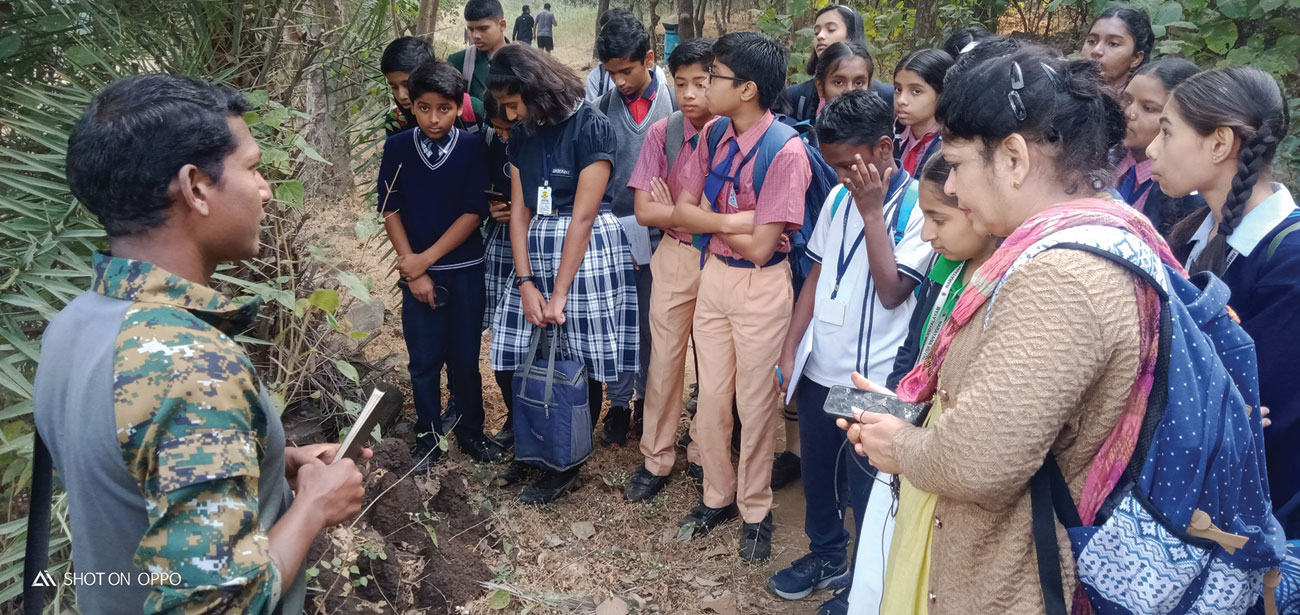
Students were enthralled to learn about anthills during their nature trail at the Gorewada Zoological Park. Photo: Sanctuary Photolibrary.
In New Delhi
A hugely successful Teachers’ Workshop for Delhi was conducted at Springdales School, Pusa Road, with teachers braving the December cold and fog to participate in the event. Bhavya Arora, Kids for Tigers, Delhi Coordinator, conducted the audio-visual show. The workshop was graced by chief guest Neha Sinha, author, environmentalist, and Sanctuary Wildlife Service Awardee 2017, who spoke about the natural heritage and biodiversity in Delhi. Teachers felt highly motivated after these sessions and wanted to implement the practical lessons they learned about wildlife, nature and environment conservation in their schools.
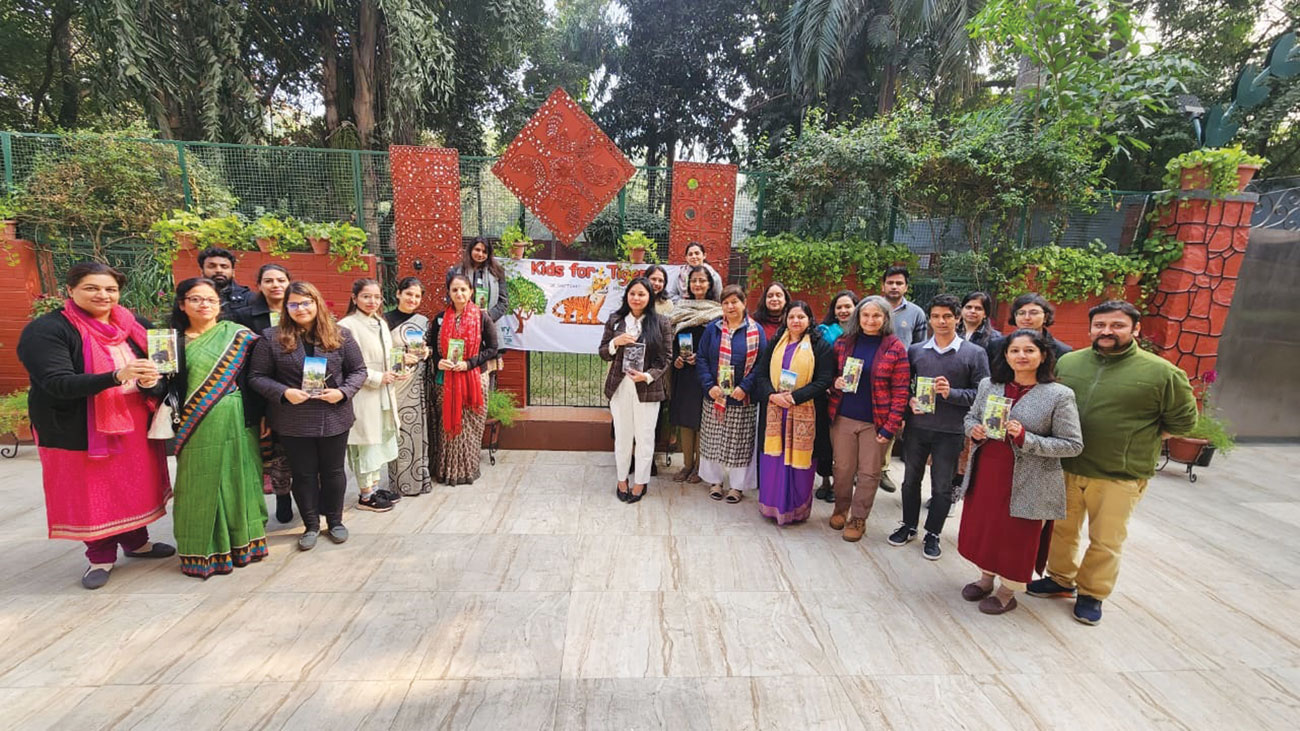
Teachers at the Delhi Kids for Tigers’ Environmental Leadership Workshop with chief guest Neha Sinha and Delhi coordinator Bhavya Arora. Photo: Sanctuary Photolibrary.
In Coimbatore, Tamil Nadu
With help from wildlife veteran Mohammed Saleem, Co-Founder of the Environment Conservation Group, a nonprofit NGO, Kids for Tigers has activated both aided and unaided schools in this city around which some of India’s finest wildlife destinations exist, including the famous Silent Valley National Park, Topslip, Anamalai, Valparai and more. School Principals have warmed up to the Kids for Tigers’ mission and have invited us to address the entire student and teacher communities at school assemblies. Slide shows, nature walks, conservation notice boards, tiger fests and an overnight camp are all part of the buffet of nature experiences that the children and teachers are being exposed to. All the above are part of agenda of the Teachers’ Environmental Leadership Workshop where educationists help to craft the communications that will be relayed to tomorrow’s citizens.
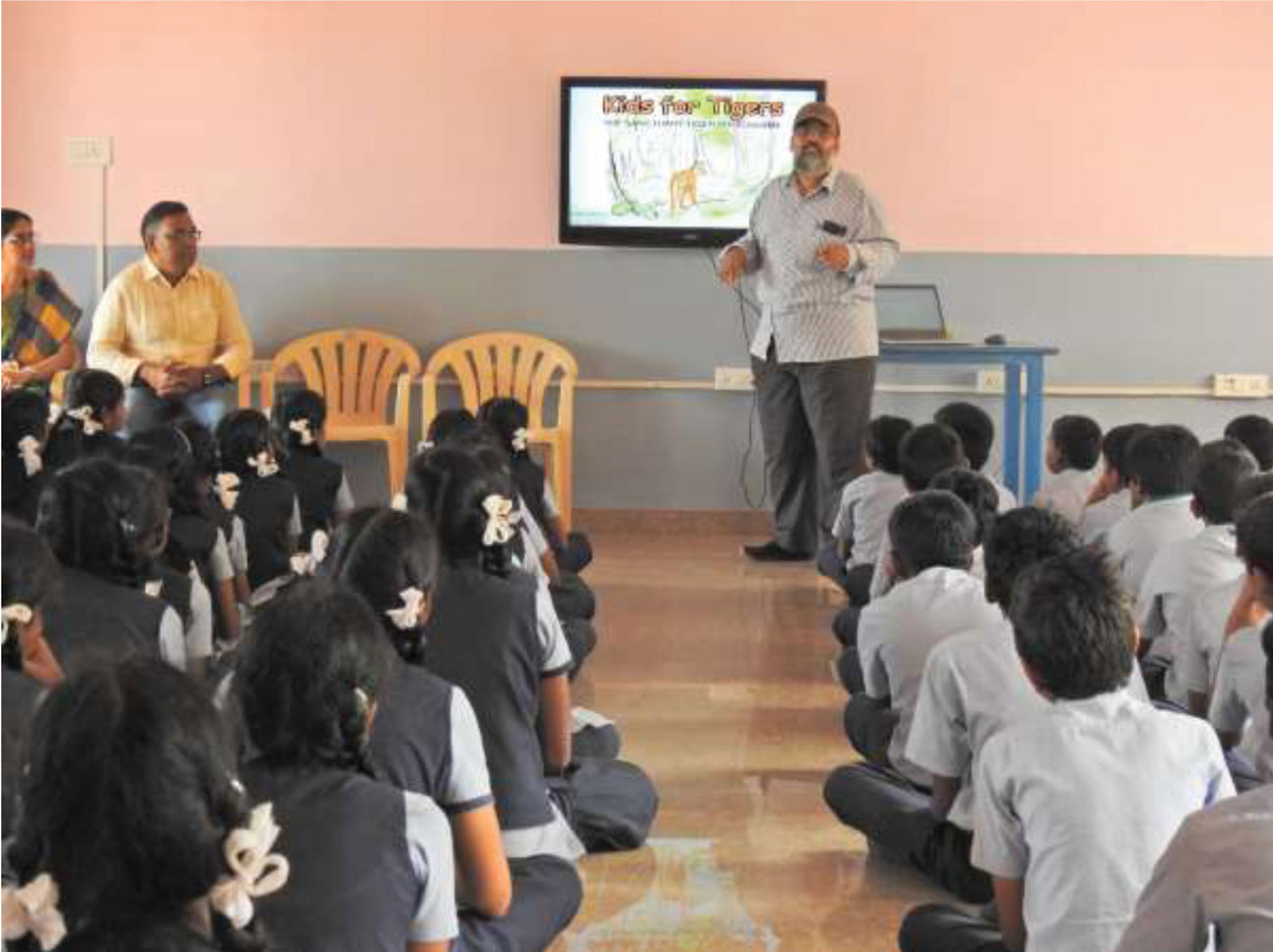
A Kids for Tigers audio-visual show was conducted at TRG Matriculation School by Md. Saleem, Coimbatore Coordinator. Photo: Sanctuary Photolibrary.
In Khajuraho and Panna, Madhya Pradesh
Khajuraho, next to the Panna Tiger Reserve, through which the exquisite Ken river flows, is one of the newest Kids for Tigers’ centres. Here our focus is primarily on small local and government-aided schools that work with underprivileged children. Such children are all too often excluded from environmental education, despite the immense need to connect them with nature… particularly those living in proximity to biodiversity-rich areas such as the Panna National Park. Many families are in fact employed with the Panna Tiger Reserve and parents and relatives of others are engaged with nature-based tourism. Here with Dr. Raghunandan Chundawat and wildlife chronicler and photographer Joanna Van Gruisen, both children and their parents are engaged in ways to deal with human-wildlife conflict. Inculcating knowledge and appreciation for the services that healthy forests offer communities is also a key part of the agenda. In the coming years, we expect that Panna will become a source of key biodiversity-climate education for India.
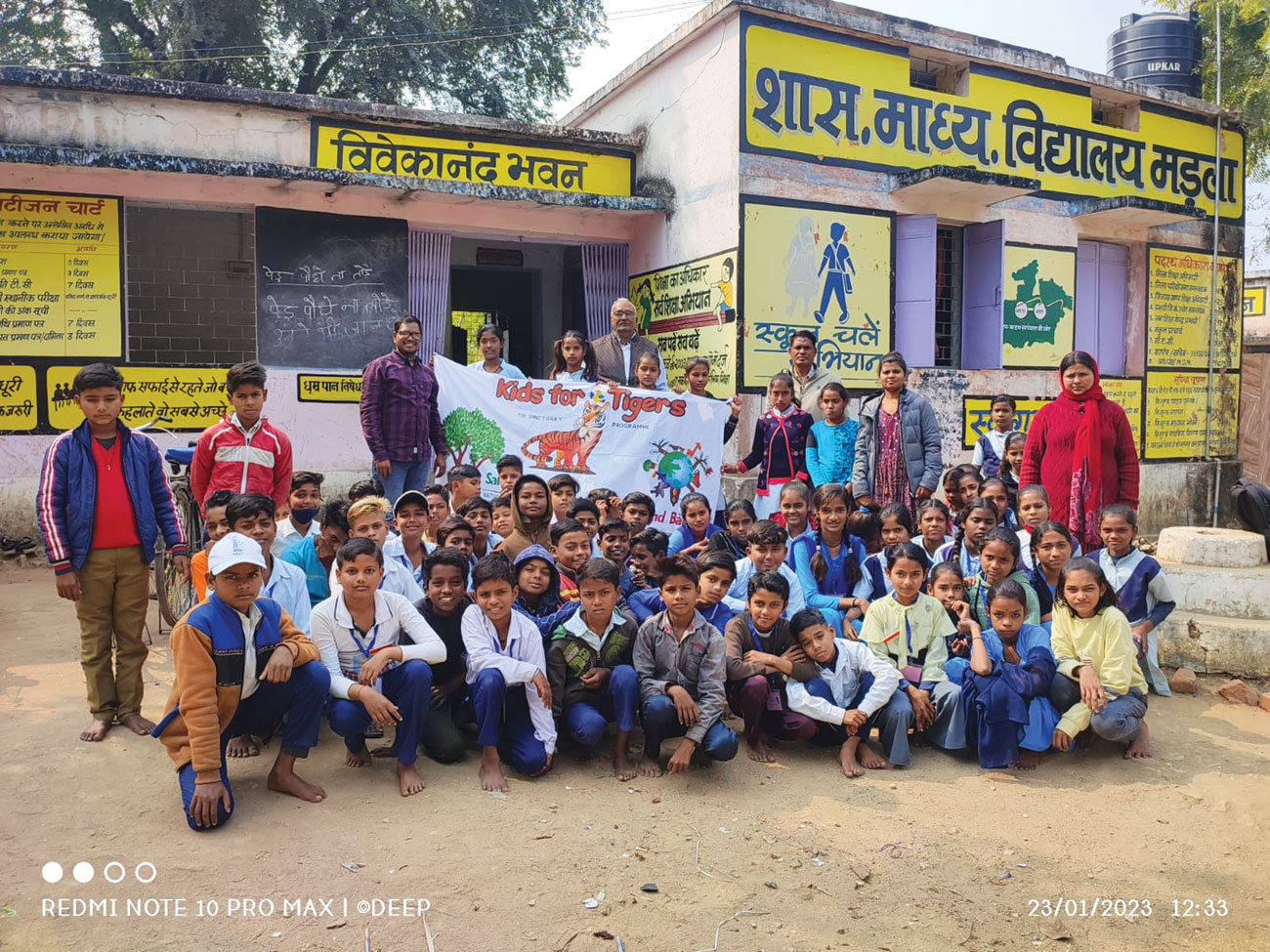
A Kids for Tigers’ audio-visual show was conducted at Government Middle School, Mandala. Photo: Sanctuary Photolibrary.
In Hyderabad, Telangana
A nature trail and Teachers’ Environmental Leadership Workshop have been completed. The nature trail was conducted at the Butterfly Park of Sanjeevaiah Children’s Park. B. Srinivas, IFS, interacted with the students and enlightened them with various facts about wildlife, plant-animal interactions, and much more. A workshop was also conducted for teachers, to inspire them to integrate environmental education into subjects they teach.
In Bengaluru, Karnataka
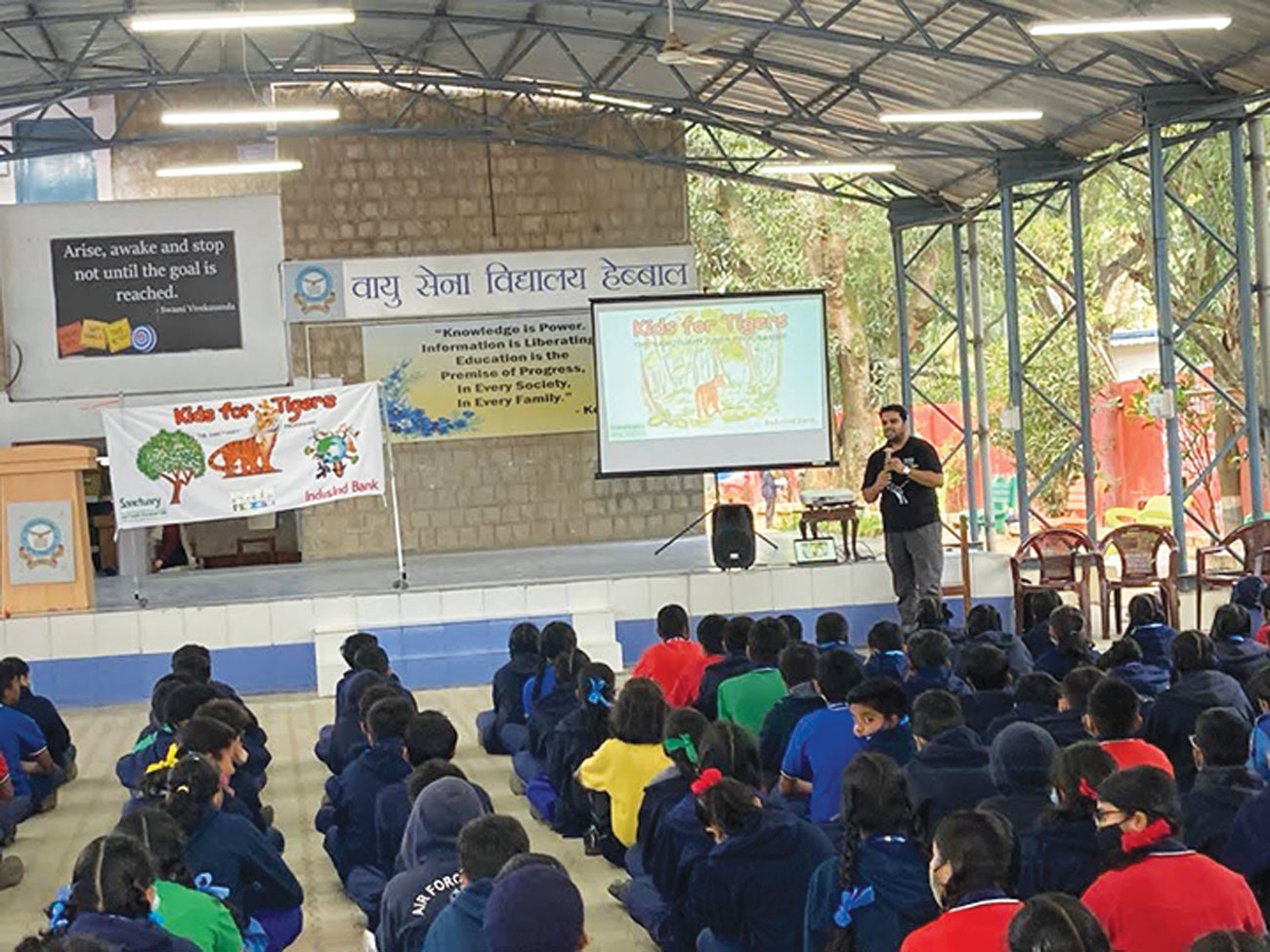
Nitin Prabhakar introducing kids to India’s biodiversity during the audio-visual show at Air Force School, Hebbal. Photo: Sanctuary Photolibrary.
Several audio-visual shows, one nature trail and the Teachers’ Environmental Leadership Workshop have been completed. The Teachers’ Workshop was conducted at Venkatappa Art Gallery Auditorium, and was attended by 34 teachers from 18 schools with chief guest being S. Karthikeyan, Chief Naturalist, Jungle Lodges and Resorts. Teachers enjoyed the informative sessions, which also included an audio-visual show. The new year started with more audio-visual shows and a nature walk. A tiger fest was held in the city on January 27, 2023.






_C-1300_1676454669.jpg)
_C-1300_1676454750.jpg)
_C-1300_1676454917.jpg)
_C-1300_1676454997.jpg)
_C-1300_1676455119.jpg)




